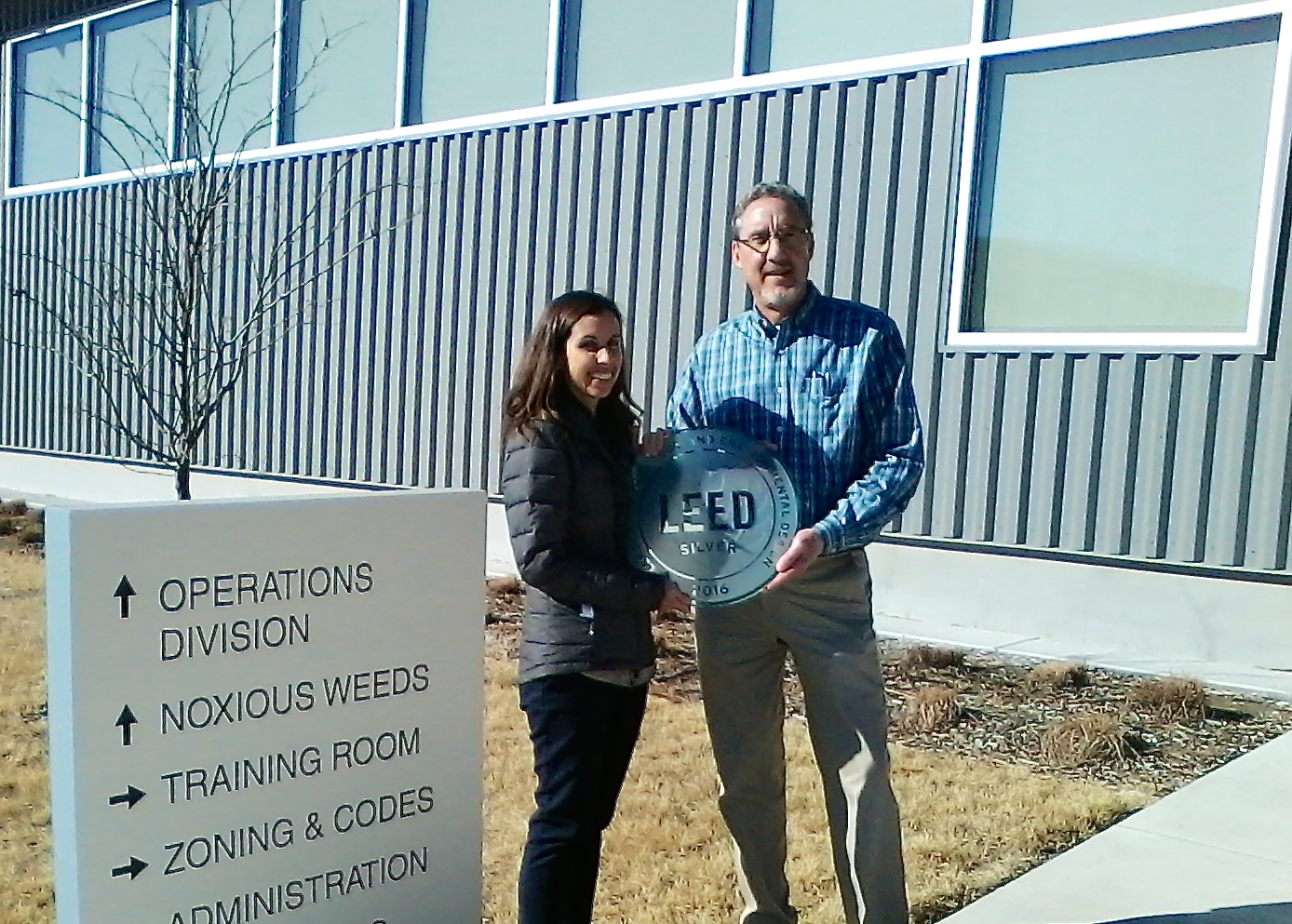Douglas County Public Works headquarters recognized for environmentally friendly design

The Douglas County Public Works facility, 3755 E. 25th Street, pictured Tuesday, Feb. 21, 2017 is the recent recipient of a Silver Award from the U.S. Green Building Council’s Leadership in Energy and Environmental Design. Many of the facilities features and its environmentally friendly design contributed to the award.
The Douglas County Public Works and Zoning and Codes complex announces its award-winning environmentally friendly design to visitors as they enter its parking lot.
There, signs notify motorists that choice parking spots are reserved for various hybrid models and small compacts.

Eileen Horn, coordinator of the Lawrence-Douglas County Sustainability Department, and Keith Browning, Douglas County Public Works Director, show off the Leadership in Energy and Environmental Design Silver Award the public works complex earned for its environmentally friendly features. The complex opened in April 2015.
“They are for fuel-efficient and low-emitting vehicles,” said Douglas County Public Works Director Keith Browning. “We have a list of qualifying vehicles.”
That’s one of the many features that earned the Public Works complex a Silver Award from the U.S. Green Building Council’s Leadership in Energy and Environmental Design program. The award is now displayed in the complex’s main building 22 months after its opening in April 2015 at 3755 E. 25th St. LEED certification comes in four levels: Certified, Gold, Silver and Platinum.

Specific parking spaces are reserved for fuel efficient vehicles.
Eileen Horn, coordinator of the Lawrence-Douglas County Sustainability Department, said the process that led to the designation started with the layout of the complex, which was developed by Lawrence architecture firm Clark-Huesemann. The buildings were clustered so as not to disturb the habitat of wildlife at the site — 49 percent of the site’s grounds are maintained as open space.
Another passive energy-saving element is the roof overhang along the length of the main building’s southern and eastern exteriors. The overhang lets the warming February sunlight flow through the building’s large glass windows, but shades them in summer when the midday sun crosses the sky further to the north, Horn said. Underneath that awning are seven bike racks, which, in tandem with the showers available inside, are meant to encourage employees to bike to work, she said.

A large portion of the facility's grounds are open space.
The site also has a 14-kilowatt solar panel, which provides 13 percent of the power to the complex. Horn said the panel was projected to save the county $100,000 in its projected 25-year-lifespan and pay for itself after 15 years. Low-flow water toilets and fixtures further save on utility bills by consuming 45 percent less water than traditional fixtures, she said.
The roofs in the complex are of a light color that reflects light and heat from the buildings to reduce energy costs, Horn said. They are sloped, too, so that the north side of the main buildings presents a smaller profile to cold winter winds.
Inside the main building, the large windows with translucent glazing allow more daylight to enter the interior and thus reduce the amount of electricity needed to light the building, Horn said. Ninety-five percent of the main building’s space has access to natural light and an outside view.
The main building earned more LEED points through the use of recycled materials, including the windows purchased from a supplier of recyclables.
“They were supposed to be used in a project that got canceled when the economy went downhill in 2008,” Horn said.
The wood planks that form the ceiling are also recycled or salvaged wood, Browning said. All told, 12 percent of the project’s materials were recycled. Of the project’s new materials, 5 percent had their origin within 500 miles of Lawrence, Horn said.
Another innovative feature is the rammed-concrete interior wall that runs much of the length of the office space in the main building. Its decorative layering is the result of different levels of iron oxide used in the dry-mix concrete, Browning said.
Energy savings and efficiency also are realized through the building’s variable refrigerant flow heating and cooling systems, which uses refrigerant as a cooling and heating medium, Browning said.
“It runs refrigerant though tubes,” he said. “It’s about as efficient as geothermal but not as expensive.”
A similar system will be installed with the renovations of the downtown Lawrence-Douglas County Fire Station No. 1 and the adjoining Senior Resource Center for Douglas County, Horn said.
Although the renovations of those two facilities will incorporate a number of energy-saving features, they will not be submitted as LEED projects, Horn said. However, the public works complex is likely to be joined by another LEED building in Lawrence.
“The Lawrence Public Library is on track to be a Gold Award building,” she said.







